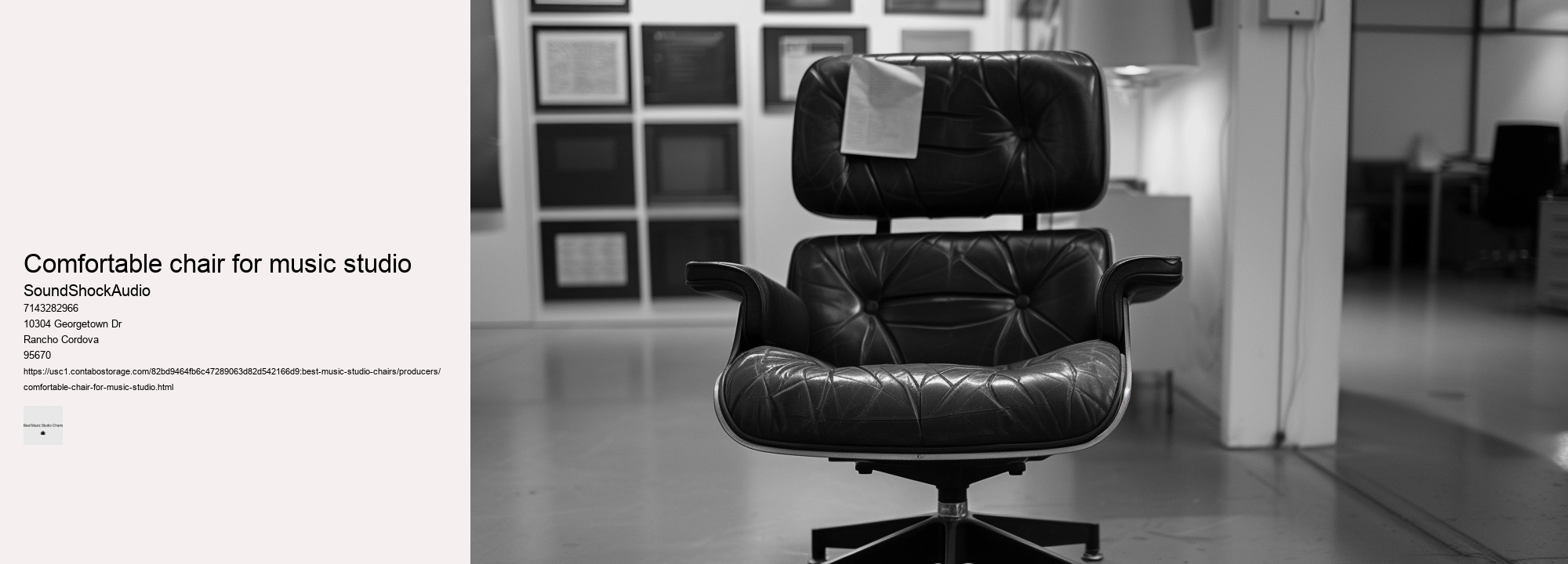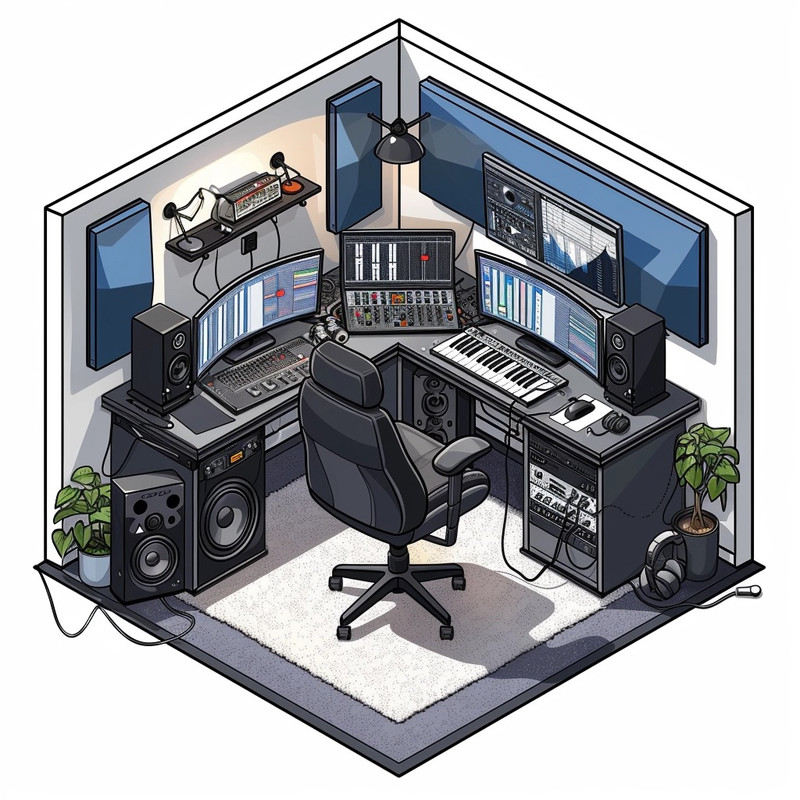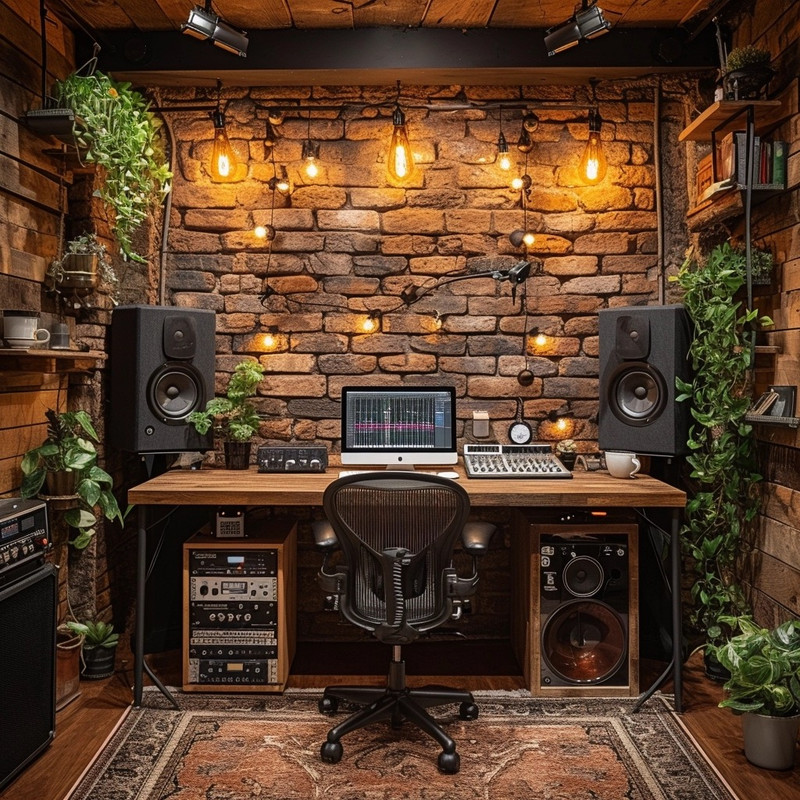

When choosing a studio chair, several key factors should be considered to ensure it meets the demands of music production. Consider also mobility; a chair with smooth-rolling casters will let you glide effortlessly from one end of your workspace to another—a tangible metaphor for seamless thought transitions from concept to execution. Creating a harmonious and functional small home studio demands meticulous attention to detail, particularly when it comes to selecting the right chair. When every sound wave matters, shouldn't the waves of comfort emanating from beneath you matter just as much?
Once upon a twilight hue, artisans of rhythm embarked on quests for perfect perches. The material of the chair also matters greatly in terms of comfort and durability. Among these titans of seating, one finds lumbar supports singing in harmony with spines bent over mixing consoles.
Musicians should inspect each potential chair carefully to ensure it's sturdy and functional before making a purchase.
Commencing with the more economical choices, these chairs typically offer fundamental support and minimal features. The throne for any serious producer isn't just about physical ease—it must also inspire confidence and enhance focus. Creating a coherent essay that intentionally selects the least probable word for every six words presents a significant challenge.
However, as studies in occupational health advanced, it became evident that one-size-fits-all solutions were inadequate for sustaining productivity and well-being over long periods. Imagine a chair designed with the precision of a finely tuned instrument—a seat that harmonizes with your body’s movements as seamlessly as a maestro conducts his orchestra.
Durability is another key consideration. This unique seat, designed with a Scandinavian touch of minimalism and ergonomic sensibility, is often not discussed in popular office furniture conversations, but it deserves acclaim.
Before a single note resonates through the studio, seasoned veterans invest time in prepping their workspace. This pursuit of auditory bliss can span hours, if not days - a testament to the dedication required to birth a musical masterpiece.
Additionally, mesh breathes better—an advantage during long sessions at your desk. Whether sleek lines sing harmonies with minimalist setups or plush cushions echo the opulence of traditional spaces, beauty must never be sacrificed at utility's altar. Seat depth adjustment is another key element often overlooked but equally vital for tailored thigh support without cutting off circulation behind the knees – especially important for taller or shorter individuals who may need more or less space than what standard non-adjustable chairs offer. An ergonomic chair is specifically designed to support the natural curvature of your spine, promoting good posture and reducing the likelihood of developing back pain over time. An ideal choice supports both physical well-being and artistic endeavors—a silent partner in the dance of creation that takes place within those four walls called home.
An optimal chair allows you to sit firmly with your feet planted on the ground while leaving a small gap between your knees and the edge of the seat. At first glance, one might consider a studio chair simply as a vessel for seated support during long hours of work. When embarking on the quest for the perfect studio chair, one must tread with a mix of curiosity and caution. Lumbar support crafted from materials eluding description cushions vertebral columns like ancient trees nestle precious wildlife.
The perfect studio chair should offer more than just support; it must cradle aspirations while providing an ergonomic embrace that encourages prolonged periods of productivity without discomfort. A chair too rigid might impede movement; one too soft could lead to poor posture and subsequent discomfort or even injury over time. weight A third whispers legend: wrought from stardust mesh that breathes like lungs filled with crisp winter air—it promises reprieve to those ensnared by sweltering beats radiating from amplifiers' hearts. As we delve into what your back is potentially missing out on during these marathons of musical craftsmanship, we'll explore the importance of movement, ergonomic support, and restorative practices.
Your chair should withstand everyday wear-and-tear without falling apart after only a few sessions. While they don't directly impact comfort or ergonomics, pleasing designs can inspire creativity—a subtle yet significant benefit for those working in creative fields. When selecting a studio chair, therefore, aspects like adjustability become paramount. DIY solutions present another improbable but effective route.


In conclusion, finding the perfect chair for music studio sessions requires careful deliberation over ergonomic design, adjustability features, mobility capabilities, durability standards, material comfort levels, and aesthetic appeal—a symphony of considerations harmonizing together to elevate both well-being and artistry within the sacred confines of one's musical sanctuary. Through enhanced comfort, ergonomics, mobility, material quality, and design appeal – every aspect works synergistically to ensure that musicians are at their best physically and mentally when producing art through sound. Moreover, materials matter when it comes to long-lasting comfort and durability. As ergonomic research continues pushing boundaries alongside technological innovations in materials engineering; studio chair designs will undoubtedly evolve even further—making today's game-changing features tomorrow's standards. Thirdly, mobility within the workspace enhances efficiency and keeps creative juices flowing.
Secondly, comfort cannot be overstated. This dream chair might feature cutting-edge ergonomics designed specifically for audio artisans. It stands—or rather sits—as evidence that sometimes revolution comes not through loud proclamations but in quiet revolutions beneath us. These chairs offer adjustable features such as lumbar support that molds to the contours of your spine, armrests that align with your natural posture, and seat pans that encourage circulation even after hours of being seated.
However, ensure the casters are tuned to your floor type; carpet demands different wheels than hardwood. In conclusion, while whimsical furniture pieces may spark temporary intrigue or amusement among musicians seeking uniqueness within their space, ultimately they fall short compared to professionally tailored solutions when aiming to unlock one's full music potential. Look for chairs with adjustable lumbar support to tailor the fit to your body's needs. Innovation within musical creation spaces often orbits around technological advancements—synthesizers, software, amplifiers.
Without lumbar support or adjustable armrests tailored to align with your body's unique specifications, your spinal alignment may suffer silently as you focus on blending tracks together. In conclusion, acknowledging the profound impact that proper seating has on preventing fatigue and injury is paramount for maintaining overall well-being. Consider materials as well: breathable meshes ensure ventilation during summer's sweltering assaults; meanwhile, supple leathers provide warmth when winter weaves its chilling tapestry across studios. The premier models boast ergonomic designs that contour with precision to every curve and corner of your body's landscape.
As we delve into finding the best chairs for enduring studio sessions, we'll consider key features that contribute to a supportive seating experience. Does sleek modern design quicken your heart? While not as advanced as some higher-end models, its simple design coupled with decent build quality makes it suitable for less intense studio environments.
Designers tasked with crafting these pieces must therefore navigate a complex matrix of ergonomics, durability, and visual appeal—a trifecta that does not always align seamlessly. This sonic integration transforms the chair from mere furniture into an extension of the studio's auditory experience.
A striking example is the incorporation of motion technology allowing seats to subtly move with the user, preventing static pressure points and promoting circulation. The aesthetics of these chairs are not merely a byproduct of function but an intentional dialogue with the very essence of style.
Incorporating standing desks or sit-stand workstations into one’s environment offers another layer of protection against the perils of sedentary behavior. Chairs designed with music producers' specific needs in mind offer tangible benefits through increased comfort levels leading to prolonged concentration spans which directly affect output quality.

Musicians should have access to comfortable seating adjusted specifically for their posture and instrument positioning, reducing physical strain over prolonged periods. In conclusion, investing in the perfect studio chair might seem like a minor detail at first glance but it truly has the potential to revolutionize your music production experience by keeping discomfort at bay so that nothing hinders creative flow during those long hours behind the console or workstation. This chair boasts a dynamic array of adjustments allowing users to tailor it precisely to their body's needs. Another aspect commonly overlooked but tremendously influential is ergonomics.
Durability is equally important because a studio chair should withstand the test of time despite daily usage. Ergonomic chairs encourage a sitting posture that aligns your back, neck, and hips, reducing strain on these areas. Angle A simple yet effective method to achieve this ambiance is by personalizing the space with comforting elements such as warm lighting or familiar artwork.
Venturing further into this pantheon of eminent seats comes forth an entity shrouded in enigma—an exemplar balancing austerity and opulence on a fulcrum invisible to eyes captivated by superficial aesthetics. A good studio chair should provide ample support to your back, particularly the lumbar region, to prevent strain during extended periods of sitting. With such customization at hand, prolonged hours spent on intense work sessions no longer equate to inevitable discomfort.
Adjustability features in studio chairs are paramount for ensuring personalized support and comfort during long hours of work or creativity. They offer tangible benefits for health and artistic expression even if our discussion includes unexpected detours like "elephants elegantly embroider euphonious echoes," which charmingly illustrates how randomness can sometimes weave poetry into prose but may leave readers bewildered regarding practical advice on choosing seating solutions for music-making endeavors. Functionality aside, aesthetics play no minor role in selection.
Music producers often spend prolonged periods seated while mixing or mastering tracks. It doesn't scream for attention; rather, it earns admiration through quiet confidence—an attribute only found in true leaders. A top-rated studio chair isn't just furniture; it’s an indispensable companion on your creative journey—a steadfast ally ensuring every note is hit with precision because you stayed comfy through those intense mixing marathons. Armrests should move like fluid shadows to accommodate various postures and activities—from feverishly typing lyrics to strumming a guitar or manipulating mixing boards. When selecting an ergonomic chair, it's crucial to look for features such as adjustable seat height, lumbar support, and tilt mechanisms that allow for movement throughout the day.
Through ergonomic furniture options combined with personal vigilance regarding posture and movement habits, we stand a much better chance of safeguarding our health against the silent yet significant threats posed by inadequate seating arrangements. Next, think about the materials used in constructing the chair. Moreover, time equals money in any production environment - be it music, video editing, or graphic design - and efficiency is king. Durability is another essential attribute since music production can sometimes be a vigorous activity filled with moments of excitement and intense focus.
Herein lies a whimsical exploration of top-tier sitting apparatuses heralded by music professionals. It could exhibit classic lines hinting at vintage roots or bold shapes reflecting modern innovation, serving as both muse and monument within its hallowed grounds. Their chairs are silent partners in this symphony of skill, providing a foundation upon which their artistry can flourish. When embarking on this journey, comfort reigns supreme.
Tailoring this aspect of a chair helps cradle the natural curve of your spine, offering targeted relief and preventing slouching. Equally important is investing time into testing chairs before making a purchase.
As of my last update in 2023, Ninja, the popular streamer and gamer, has been known to use the Maxnomic Dominator gaming chair. This chair is part of the Maxnomic gaming chair line, which is designed for comfort and durability during long gaming sessions. It features adjustable armrests, lumbar support, and a reclining function to ensure ergonomic support for gamers.
An ergonomic chair is best for hip and back pain as it is designed to support the natural curvature of the spine, promote good posture, and reduce pressure on the hips. These chairs often feature adjustable components such as lumbar support, seat depth, and armrests to fit the user's body dimensions and needs. Additionally, chairs with a slight recline and a comfortable, cushioned seat can help distribute weight evenly and reduce strain on the hips and back.
DJs get paid so much because they play a crucial role in the entertainment industry, creating and controlling the atmosphere at clubs, parties, and events. Their ability to engage and energize a crowd, combined with the skill required to mix tracks seamlessly, adds significant value to any event. Additionally, top DJs have a strong following and can draw large crowds, which translates to higher ticket sales and revenue for event organizers.
The cost of a decent office chair can vary widely depending on factors such as ergonomics, materials, brand, and features. Generally, a good quality office chair can range from $100 to $500. However, for chairs with advanced ergonomic features, premium materials, or designer brands, prices can go significantly higher, even exceeding $1000. It's important to balance budget with the need for comfort, especially if you'll be using it for long hours.
Apple uses the Vitra Pacific Chair in many of its office spaces, including Apple Park in Cupertino. This choice was personally overseen by Jony Ive, Apple's former Chief Design Officer, reflecting the company's minimalist design ethos. The Pacific Chair is known for its sleek design and ergonomic features, aligning with Apple's aesthetic and functional preferences.